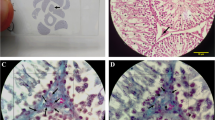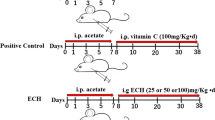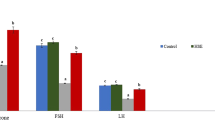Abstract
The present study was aimed to investigate the beneficial effects of N-acetyl-l-cysteine (NAC, 150 mg/kg bw twice/week) against testicular germ cell apoptosis in rats induced by chronic hCG administration (100 IU/rat/day for 30 days). NAC co-treatment improved serum testosterone, prevented rise in lipid peroxidation, intracellular H2O2 and the activities of antioxidant enzymes in germ cells. Replenishment of intracellular GSH and total antioxidant capacity was seen. There was a marked reduction in TUNEL positive germ cells and expression of caspase-3 (p < 0.01) and PARP cleavage. Pro-apoptotic markers Fas, FasL, caspase-8 were also significantly downregulated. While Bcl-2 was fully restored, rise in Bax, caspase-9, phospho-JNK/JNK and phospho-c-Jun/c-Jun expression was significantly arrested. Anti-apoptotic phospho-Akt/Akt and NF-κB were otherwise found upregulated. Taken together, the above findings demonstrate that NAC intervention rescued the testicular germ cells from demise following chronic hCG treatment through regulation of multiple signaling mechanisms of metazoan apoptosis.













Similar content being viewed by others
References
Kaleva M, Arsalo A, Louhimo I, Rapola J, Perheentupa J, Henriksen K, Toppari J (1996) Treatment with human chorionic gonadotropin for cryptorchidism: clinical and histological effects. Int J Androl 19:293–298
Dunkel L, Taskinen S, Hovatta O, Tilly JL, Wikstrom S (1997) Germ cell apoptosis after treatment of cryptorchidism with human chorionic gonadotropin is associated with impaired reproductive function in the adult. J Clin Invest 100:2341–2346
Ritzen EM (2008) Undescended testes: a consensus on management. Eur J Endocrinol 159(Suppl 1):S87–S90
Zitzmann M, Nieschlag E (2000) Hormone substitution in male hypogonadism. Mol Cell Endocrinol 161:73–88
Giannopoulos MF, Vlachakis IG, Charissis GC (2001) 13 years experience with the combined hormonal therapy of cryptorchidism. Horm Res 55:33–37
Aycan Z, Ustunsalih-Inan Y, Cetinkaya E, Vidinlisan S, Ornek A (2006) Evaluation of low-dose hCG treatment for cryptorchidism. Turk. J. Paediatr. 48:228–231
Depenbusch M, von Eckardstein S, Simoni M, Nieschlag E (2002) Maintenance of spermatogenesis in hypogonadotropic hypogonadal men with human chorionic gonadotropins alone. Eur J Endocrinol 147:617–624
Heiskanen P, Billig H, Toppari J, Kaleva M, Arsalo A, Rapola J, Dunkel K (1996) Apoptotic cell death in the normal and cryptorchid human testis: the effect of human chorionic gonadotropin on testicular cell survival. Pediatr Res 40:351–356
Cortes D, Thorup J, Visfeldt J (2000) Hormonal treatment may harm the germ cells in 1 to 3-year-old boys with cryptorchidism. J Urol 163:1290–1292
Kerr JB, Sharpe RM (1989) Focal disruption of spermatogenesis in the testis of adult rats after a single administration of human chorionic gonadotropin. Cell Tissue Res 257:163–169
Chatani F (2006) Possible mechanism for testicular focal necrosis induced by hCG in rats. J Toxicol Sci 31:291–303
Kaya C, Karaman MI, Pirincci N, Ozturk M, Yilmazgumrukcu G (2006) Human chorionic gonadotropin deteriorates the histology of rat testes. Urol Int 76:274–277
Gautam DK, Misro MM, Chaki SP, Kaushik M, Sehgal N (2007) hCG treatment increases H2O2 levels and induces germ cell apoptosis in the rat testis. Apoptosis 12:1173–1182
Aggarwal A, Misro MM, Maheshwari A, Sehgal N (2012) Differential modulation of apoptotic gene expression by NAC in Leydig cells stimulated persistently with hCG in vivo. Mol Cell Endocrinol 348:155–164
Payabvash S, Salmasi AH, Kiumehr S, Tavangar SM, Nourbakhsh B, Faghihi SH, Dehpour AR (2007) Salutary effects of N-acetylcysteine on apoptotic damage in a rat model of testicular torsion. Urol Int 79(3):248–254
Duarte F, Blaya R, Teloken PE, Becker D, Fernandes M, Rhoden EL (2010) The effects of N-acetylcysteine on spermatogenesis and degree of testicular germ cell apoptosis in an experimental model of varicocele in rats. Int Urol Nephrol 42(3):603–608
Aktas BK, Bulut S, Bulut S, Baykam MM, Ozden C, Senes M, Yucel D, Memis A (2010) The effects of N-acetylcysteine on testicular damage in experimental testicular ischemia/reperfusion injury. Pediatr Surg Int 26(3):293–298
Maheshwari A, Misro MM, Aggarwal A, Sharma RK, Nandan D (2011) N-Acetyl-l-cysteine counteracts oxidative stress and prevents H2O2 induced germ cell apoptosis through down-regulation of caspase-9 and JNK/c-Jun. Mol Reprod Dev 78:69–79
Maheshwari A, Misro MM, Aggarwal A, Sharma RK, Nandan D (2009) Pathways involved in testicular germ cell apoptosis induced by H2O2 in vitro. FEBS. J. 276:870–881
Rao AVSK, Shaha C (2002) N-acetylcysteine prevents MAA induced male germ cell apoptosis: role of glutathione and cytochrome c. FEBS Lett 527:133–137
Russell LD, Clermont Y (1977) Degeneration of germ cell in normal, hypophysectomized and hormone treated hypophysectomized rats. Anat. Rec. 187:347–366
Ahmad AK, Wang G, Ahmed K (2006) Intracellular hydrogen peroxide production is an upstream event in apoptosis induced by down-regulation of casein kinase 2 in prostate cancer cells. Mol. Cancer. Res. 4(5):331–338
Ohkawa H, Ohishi N, Yagi K (1979) Assay for lipid peroxidation in animal tissues by thiobarbituric acid reaction. Anal Biochem 95:351–358
Das K, Samanta L, Chainy GBN (2000) A modified spectrophotometric assay of superoxide dismutase using nitrite formation of superoxide radicals. Indian J Biochem Biophys 37:201–204
Aebi H (1984) Catalse in vitro. Meth. Enzymol. 105:121–126
Habig WH, Pabst MJ, Jakoby WB (1974) Glutathione-s-transferase. J Biol Chem 249:7130–7139
Ruwanpura SM, McLachlan RI, Stanton PG, Loveland KL, Meachem SJ (2008) Pathways involved in testicular germ cell apoptosis in immature rats after FSH suppression. J Endocrinol 197:35–43
Bozec A, Chuzel F, Chater S, Paulin C, Bars R, Benahmed M, Mauduit C (2004) The mitochondrial-dependent pathway is chronically affected in testicular germ cell death in adult rats exposed in utero to anti-androgens. J Endocrinol 183:79–90
Fogarty MP, Downer EJ, Campbell V (2003) A role for c-Jun N-terminal kinase 1 (JNK1), but not JNK2, in the β-amyloid-mediated stabilization of protein p53 and induction of the apoptotic cascade in cultured cortical neurons. Biochem J 371:789–798
Trabado S, Maione L, Salenave S, Baron S, Galland F, Bry-Gauillard H, Guiochon-Mantel A, Chanson P, Pitteloud N, Sinisi AA, Brailly-Tabard S, Young J (2011) Estradiol levels in men with congenital hypogonadotropic hypogonadosim and the effects of different modalities of hormonal treatment. Fertil Steril 95:2324–2329
Chandrasekharam VV, Srinivas M, Das SN, Jha P, Bajpai M, Chaki SP, Misro MM (2003) Prepubertal human chorionic gonadotropin injection affects postpubertal germ cell maturation and androgen production in rat testis. Urology 62:571–574
Chaki SP, Misro MM, Gautam DK, Kaushik M, Ghosh D, Chainy GB (2006) Estradiol treatment induces testicular oxidative stress and germ cell apoptosis in rats. Apoptosis 11:1427–1437
Zafarullah M, Li WQ, Sylvester J, Ahmad M (2003) Molecular mechanisms of N-acetylcysteine actions. Cell Mol Life Sci 60:6–20
Roberfroid M, Calderon PB (1995) Free radical and oxidation phenomena in biological systems. Marcel Dekker Inc, New York
Oeda T, Henkel R, Ohmori H, Schill W-B (1997) Scavenging effect of N-acetyl-l-cysteine against reactive oxygen species in human semen: a possible therapeutic modality for male factor infertility? Andrologia 29:125–131
Dodd S, Dean O, Copolov DL, Malhi GS, Berk M (2008) N-acetylcysteine for antioxidant therapy: pharmacology and clinical utility. Expert Opin Biol Ther 8:1955–1962
Ciftci H, Verit A, Savas M, Yeni E, Erel O (2009) Effects of N-acetylcysteine on semen parameters and oxidative/antioxidant status. Urology 74:73–76
Chainy GBN, Samantaray S, Samanta L (1997) Testosterone induced changes in testicular antioxidant system. Andrologia 29:343–347
Sundaresan M, Yu ZX, Ferrans VJ, Irani K, Finkel T (1995) Requirement for generation of H2O2 for platelet-derived growth factor signal transduction. Science 270:296–299
Aitken RJ, Gordon E, Harkiss D, Twigg JP, Milne P, Jennings Z, Irvine DS (1998) Relative impact of oxidative stress on the functional competence and genomic integrity of human spermatozoa. Biol Reprod 59:1037–1046
Chaki SP, Ghosh D, Misro MM (2003) Simultaneous increase n germ cell apoptosis and oxidative stress under acute unilatertal testicular ischemia in rats. Int J Androl 26:319–328
Chaki SP, Misro MM, Ghosh D, Gautam DK, Srinivas M (2005) Apoptosis and cell removal in the cryptorchid rat testis. Apoptosis 10:395–405
Wu YJ, Muldoon LL, Neuwelt EA (2005) The chemoprotective agent N-acetylcysteine blocks cisplatin-induced apoptosis through caspase signaling pathway. J. Pharmacol. Exp. Therapeut. 312:424–431
Reid AJ, Shawcross SG, Hamilton AE, Wiberg M, Terenghi G (2009) N-Acetylcysteine alters apoptotic gene expression in axotomized primary sensory afferent sub-populations. Neurosci Res 65:148–155
Ji L, Liu T, Chen Y, Wang Z (2009) Protective mechanisms of N-acetyl-cysteine against pyrrolizidine alkaloid clivorine-induced hepatotoxicity. J Cell Biochem 108:424–432
Guazzone VA, Jacobo P, Theas MS, Lustig L (2009) Cytokines and chemokines in testicular inflammation: a brief review. Microsc Res Tech 72:620–628
Rodriguez I, Ody C, Araki K, Garcia I, Vassalli P (1997) An early and massive wave of germinal cell apoptosis is required for the development of functional spermatogenesis. EMBO J 16:2262–2270
Lizama C, Alfaro I, Reyes JG, Moreno RD (2007) Up-regulation of CD95 Apo-1/Fas is associated with spermatocyte apoptosis during the first round of spermatogenesis in the rat. Apoptosis 12:499–512
Mishra DP, Shaha C (2005) Estrogen-induced spermatogenic cell apoptosis occurs via the mitochondrial pathway: role of superoxide and nitric oxide. J Biol Chem 280:6181–6196
Francavilla S, D’Abrizio P, Cordeschi G, Pelliccione F, Necozione S, Ulisse S, Properzi G, Francavilla F (2002) Fas expression correlates with human germ cell degeneration in meiotic and post-meiotic arrest of spermatogenesis. Mol. Hum. Reprod. 8:213–220
Tanel A, Averill-Bates DA (2007) Inhibition of acrolein-induced apoptosis by the antioxidant N-acetylcysteines. J Pharmacol Exp Ther 321:73–83
Huang W, Dobberfuhl A, Filippopoulos T, Ingelsson M, Fileta JB, Poulin AR, Grosskreutz CL (2005) Transcriptional up regulation and activation of initiating caspases in experimental glaucoma. Am J Pathol 167:673–681
Chausiaux OE, Abel MH, Baxter FO, Khaled WT, Ellis PJ, Charlton HM, Affara NA (2008) Hypogonadal mouse, a model to study the effect of the endogenous lack of gonadotropins on apoptosis. Biol Reprod 78:77–90
Fujisawa M, Kanzaki M, Tatsumi N, Okuda Y, Okada H, Arakawa S, Kamidono S (2000) Inhibition of apoptosis in cultured immature rat Leydig cells by human chorionic gonadotropin associated with Bcl-2 mRNA expression. Endocr Res 26:59–70
Chandrasekaran Y, Richburg JH (2005) The p53 protein influences the sensitivity of testicular germ cells to mono-(2-ethylhexyl) phthalate-induced apoptosis by increasing the membrane levels of Fas and DR5 and decreasing the intracellular amount of c-FLIP. Biol Reprod 72:206–213
Erkkila K, Hirvonen V, Wuokko E, Parvinen M, Dunkel L (1998) N-acetyl-l-cysteine inhibits apoptosis in human male germ cells in vitro. J Clin Endocrinol Metab 83:2523–2531
de Flora S, Izzotti A, D’Agostini F, Balansky RM (2001) Mechanisms of N-acetylcysteine in the prevention of DNA damage and cancer, with special reference to smoking-related end-points. Carcinogenesis 22:999–1013
Hashimoto S, Gon Y, Matsumoto K, Takeshita I, Horie T (2001) N-acetylcysteine attenuates TNF-alpha-induced p38 MAP kinase activation and p38 MAP kinase-mediated IL-8 production by human pulmonary vascular endothelial cells. Br J Pharmacol 132:270–276
Wada T, Penninger JM (2004) Mitogen-activated protein kinases in apoptosis regulation. Oncogene 23:2838–2849
Nicholson KM, Anderson NG (2002) The protein kinase B/Akt signalling pathway in human malignancy. Cell Signal 14:381–395
Mehta A, Sekhon CPS, Giri S, Orak JK, Singh AK (2002) Attenuation of ischemia/reperfusion induced MAP kinase by N-acetyl cysteine, sodium nitroprusside and phosphoramidon. Mol Cell Biochem 240:19–29
Acknowledgments
Senior Research Fellowship (SRF) to Ankur Maheshwari from Council of Scientific and Industrial Research (CSIR), New Delhi, India is greatly acknowledged. The study was funded jointly by CSIR and NIHFW.
Conflict of interest
No potential conflicts of interest to disclose.
Author information
Authors and Affiliations
Corresponding author
Electronic supplementary material
Below is the link to the electronic supplementary material.
Rights and permissions
About this article
Cite this article
Maheshwari, A., Misro, M.M., Aggarwal, A. et al. N-acetyl-l-cysteine modulates multiple signaling pathways to rescue male germ cells from apoptosis induced by chronic hCG administration to rats. Apoptosis 17, 551–565 (2012). https://doi.org/10.1007/s10495-012-0703-8
Published:
Issue Date:
DOI: https://doi.org/10.1007/s10495-012-0703-8




